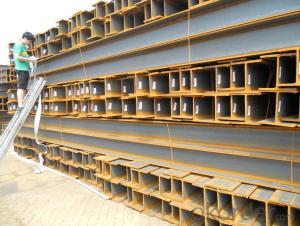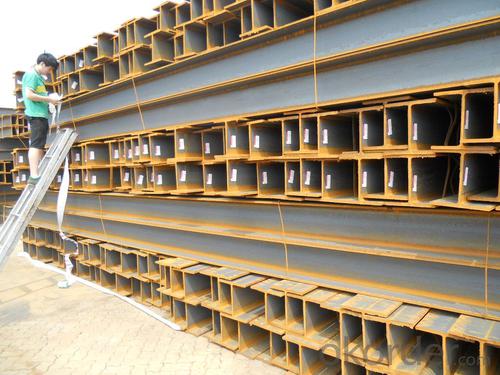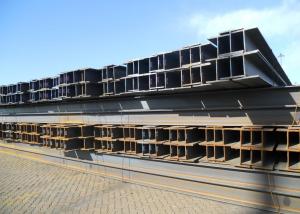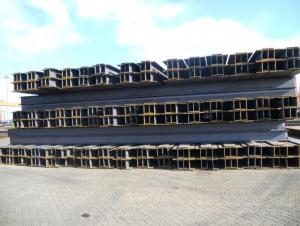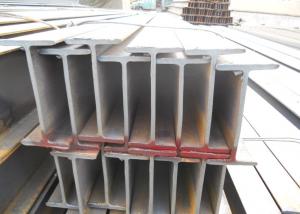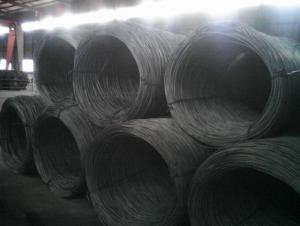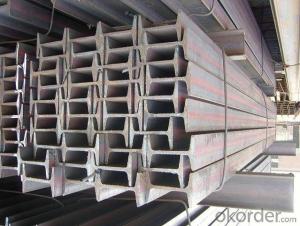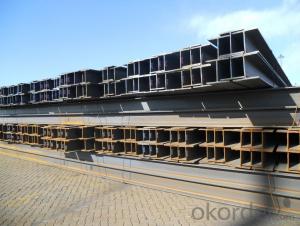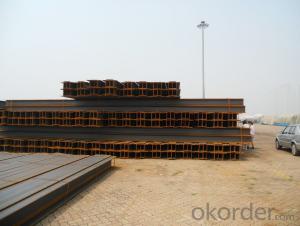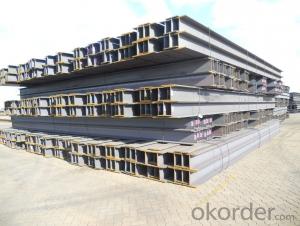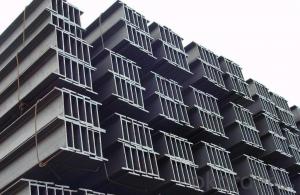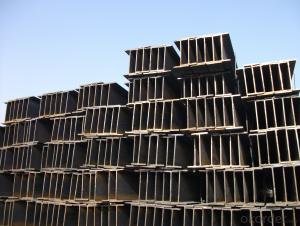JIS Standard SS400 H beams with Good Quality 340mm-396mm
- Loading Port:
- Tianjin
- Payment Terms:
- TT or LC
- Min Order Qty:
- 100 m.t
- Supply Capability:
- 15000 m.t/month
OKorder Service Pledge
OKorder Financial Service
You Might Also Like
Specifications of JIS Standard SS400 H beams with Good Quality 340mm-396mm:
1. Standard: JIS 3192
2. Grade: SS400 or Equivalent
3. Length: 10m, 12m as following table
4. Invoicing on theoretical weight or actual weight as customer request
5.Payment: TT or L/C
Size and Mass of JIS Standard SS400 H beams with Good Quality 340mm-396mm:
| Size (mm) | Mass (Kg/m) | Size (mm) | Mass (Kg) |
| 340*250*9.0 | 78.1 | 350*350*12.0 | 135 |
| 344*348*10.0 | 113 | 396*199*7.0 | 56.1 |
Packaging & Delivery of JIS Standard SS400 H beams with Good Quality 340mm-396mm for Building Structures:
1. Packing: it is nude packed in bundles by steel wire rod
2. Bundle weight: not more than 3.5MT for bulk vessel; less than 3 MT for container load
3. Transportation: the goods are delivered by truck from mill to loading port, the maximum quantity can be loaded is around 40MTs by each truc4. If the order quantity cannot reach the full truck loaded, the transportation cost per ton will be little higher than full load.
4. Delivered by container or bulk vessel
Usage of JIS Standard SS400 H beams with Good Quality 340mm-396mm:
(1). for the plant, high-rise building construction
(2). for the bridge, shipment building
(3).for lifting and transportation machinery, equipment manufacturing base building
(4). for the support, foundation pile manufacturing
FAQ:
Q1: Why buy Materials & Equipment from OKorder.com?
A1: All products offered by OKorder.com are carefully selected from China's most reliable manufacturing enterprises. Through its ISO certifications, OKorder.com adheres to the highest standards and a commitment to supply chain safety and customer satisfaction.
Q2: How do we guarantee the quality of our products?
A2: We have established an advanced quality management system which conducts strict quality tests at every step, from raw materials to the final product. At the same time, we provide extensive follow-up service assurances as required.
Q3: How soon can we receive the product after purchase?
A3: Within three days of placing an order, we will arrange production. The shipping date is dependent upon the quatity, how many sizes you want and the plan of production, but is typically 1 month to 2 months days from the beginning of production.
Images of JIS Standard SS400 H beams with Good Quality 340mm-396mm:


* If you would like to get our price, please inform us the size, standard/material and quantity. Thank you very much for your attention.
- Q: What are the environmental impacts of steel H-beams?
- The production and use of steel H-beams have several environmental impacts. Firstly, the production of steel involves the extraction of iron ore, which can lead to habitat destruction and soil erosion. Additionally, the mining process often requires the use of heavy machinery, which contributes to air and noise pollution. The manufacturing process of steel H-beams itself is energy-intensive, requiring high temperatures and significant amounts of electricity. This reliance on fossil fuels for energy contributes to greenhouse gas emissions, contributing to climate change. Furthermore, the production of steel H-beams involves the use of various chemicals and additives, such as coke, limestone, and coal, which can release harmful pollutants into the air and water. These pollutants include sulfur dioxide, nitrogen oxides, and heavy metals, which can have adverse impacts on human health and ecosystems. Transportation also plays a role in the environmental impact of steel H-beams. These beams are often transported over long distances, which leads to additional carbon emissions from the burning of fossil fuels in trucks or ships. Lastly, steel H-beams are typically used in construction projects, which can result in the destruction of natural habitats and ecosystems. This can lead to the displacement or extinction of certain species, as well as the loss of biodiversity. To mitigate these environmental impacts, several measures can be taken. The steel industry can invest in cleaner production technologies and energy-efficient processes, reducing greenhouse gas emissions. Recycling of steel is also an effective way to minimize environmental impacts, as it reduces the need for raw materials extraction and energy consumption. Additionally, sustainable forest management practices can be employed to minimize habitat destruction during construction projects. Overall, while steel H-beams are a crucial component in many construction projects, it is important to be aware of their environmental impacts and take steps to minimize and mitigate these effects.
- Q: Are steel H-beams suitable for supporting nuclear power plant facilities?
- Indeed, nuclear power plant facilities can be effectively supported by steel H-beams. These H-beams are widely used in construction owing to their remarkable strength and ability to bear heavy loads. They offer exceptional structural support and stability, making them an ideal choice for the substantial equipment and structures present in nuclear power plants. Furthermore, steel H-beams possess exceptional resistance to fire, corrosion, and seismic activities, which are vital characteristics for a facility engaged in such delicate operations. Moreover, steel H-beams can be tailored to meet specific design requirements and can be easily adjusted or substituted if necessary. All in all, steel H-beams guarantee reliability and durability when it comes to supporting nuclear power plant facilities.
- Q: What are the different types of coatings available for fire protection of steel H-beams?
- There are several types of coatings available for fire protection of steel H-beams, including intumescent coatings, cementitious coatings, and epoxy-based coatings. Intumescent coatings are often used as a passive fire protection measure, as they expand when exposed to high temperatures, forming a layer of insulating char that slows down the transfer of heat to the steel. Cementitious coatings, on the other hand, are typically applied in multiple layers and provide fire resistance by releasing water vapor when exposed to heat, creating a cooling effect. Epoxy-based coatings offer a combination of fire resistance and corrosion protection, as they form a protective film on the surface of the steel, reducing the risk of fire and preventing corrosion. The selection of the appropriate coating depends on factors such as the desired fire rating, environmental conditions, and aesthetic considerations.
- Q: Can Steel H-Beams be used in laboratory or research facility construction?
- Yes, Steel H-Beams can be used in laboratory or research facility construction. They are commonly used for their structural strength, durability, and ability to support heavy loads. Steel H-Beams provide stability and are often preferred for their resistance to fire, earthquakes, and other potential hazards. Furthermore, their versatility allows for easy integration into various architectural designs and flexible space arrangements.
- Q: How do steel H-beams perform in heavy snow loads?
- Steel H-beams perform exceptionally well in heavy snow loads due to their structural strength and durability. The H-shape design of the beam provides excellent load-bearing capabilities, allowing it to withstand the weight of accumulated snow without deformation or failure. Additionally, steel is known for its resistance to extreme weather conditions, including snow and ice, making H-beams a reliable choice for structures in snowy areas.
- Q: How do steel H-beams compare to I-beams in terms of strength?
- Steel H-beams and I-beams are commonly used in construction but differ in shape and design, resulting in varying load-bearing capacities. H-beams, also known as wide flange beams, possess a wider flange and narrower web compared to I-beams. This design enables H-beams to support heavy loads across a broader span, making them suitable for applications requiring greater strength and stability. The wider flange of H-beams enhances resistance against bending, torsional forces, and shear stress, making them well-suited for structures like bridges, buildings, and heavy machinery. Conversely, I-beams, also known as universal beams or rolled steel joists, possess a narrow flange and thicker web. This shape allows I-beams to resist bending and deflection, making them ideal for applications requiring long spans and minimal sagging. I-beams find common usage in residential and commercial construction, as well as in beam and column manufacturing. To compare the strength of H-beams and I-beams, it is essential to consider specific dimensions, material properties, and loading conditions. Generally, H-beams exhibit higher load-bearing capacities due to their wider flange and superior resistance against various forces. However, consulting structural engineers or referring to load tables is crucial for determining the appropriate beam type and size for a specific construction project. In summary, steel H-beams and I-beams are robust structural elements, with H-beams typically possessing higher load-bearing capacities due to their wider flange design. Nonetheless, the choice between H-beams and I-beams depends on the specific project requirements and loading conditions.
- Q: Can steel H-beams be used for architectural purposes?
- Yes, steel H-beams can be used for architectural purposes. They are commonly used in construction to create structural support for buildings, bridges, and other architectural elements. The H-beams provide strength, stability, and versatility, making them suitable for various architectural designs and applications.
- Q: Light thin-walled H steel, in addition to welding, is there any hot rolling?
- Domestic H steel production line is about 10, mainly from Germany to introduce production lines.
- Q: How do steel H-beams perform in areas with high wind uplift?
- Steel H-beams perform exceptionally well in areas with high wind uplift. Due to their structural integrity and resistance to bending and deformation, H-beams can effectively withstand the strong upward forces created by high winds, ensuring stability and safety in such conditions.
- Q: Can steel H-beams be used in the construction of cultural complexes or museums?
- Certainly, cultural complexes or museums can utilize steel H-beams for construction purposes. The widespread use of steel H-beams in various construction projects is due to their strength, durability, and versatility. These beams offer exceptional structural support, making them appropriate for the construction of large and intricate structures, such as cultural complexes or museums. To accommodate a variety of exhibits, displays, and visitor traffic, cultural complexes and museums often necessitate distinctive architectural designs and open spaces. Steel H-beams can facilitate the creation of expansive open spaces without the need for multiple supporting columns. Consequently, this allows for flexible floor plans and uninterrupted views. In cultural complexes and museums, this is particularly crucial as it permits unrestricted movement of visitors and facilitates the display of sizable artworks or artifacts. Moreover, steel H-beams are renowned for their capacity to withstand substantial loads and provide stability. This quality proves vital in cultural complexes and museums, where exhibits, artworks, and other installations can bear significant weight. Steel H-beams efficiently bear these loads, ensuring the structural integrity and safeguarding of valuable cultural assets. Additionally, steel H-beams are highly adaptable and can be seamlessly integrated into diverse architectural designs. They can be combined with materials such as glass or concrete, resulting in visually appealing and contemporary structures. Furthermore, steel H-beams offer considerable flexibility in terms of design, enabling architects to create distinctive and iconic structures that accurately reflect the cultural significance of the complex or museum. In conclusion, steel H-beams are an excellent choice for the construction of cultural complexes or museums. Their strength, durability, and versatility render them suitable for supporting large and intricate structures. Furthermore, their ability to withstand heavy loads ensures the preservation and safety of cultural assets. Additionally, their adaptability empowers architects to fashion visually captivating and iconic designs that accurately convey the cultural significance of the project.
Send your message to us
JIS Standard SS400 H beams with Good Quality 340mm-396mm
- Loading Port:
- Tianjin
- Payment Terms:
- TT or LC
- Min Order Qty:
- 100 m.t
- Supply Capability:
- 15000 m.t/month
OKorder Service Pledge
OKorder Financial Service
Similar products
Hot products
Hot Searches
Related keywords
